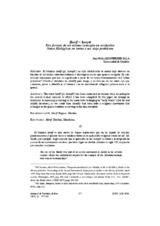Mostrar el registro sencillo del ítem
Hanīf < hanpā. Dos formas de un mismo concepto en evolución. Notas filológicas en torno a un viejo problema
| dc.contributor.author | Monferrer-Sala, J. P. | |
| dc.date.accessioned | 2012-06-06T11:00:06Z | |
| dc.date.available | 2012-06-06T11:00:06Z | |
| dc.date.issued | 2003 | |
| dc.identifier.uri | http://hdl.handle.net/10396/7272 | |
| dc.description.abstract | El término hanīf(pl. hunafā) ha sido identificado de modo muy diverso en función de los varios contextos textuales e ideológicos en los que aparece recogido. En este artículo intentamos precisar su significado a partir de los textos fundamentales del “islam primitivo” (Corán y literatura de ahādīt) para luego, y en función de los datos con que contamos, pasar a identificar el término con un movimiento religioso perteneciente a la gnosis. | es_ES |
| dc.description.abstract | The word hanīf (pl. hunafā) has been connected in various ways according to the several textual contexts in which it has been compiled. In this paper we attempt to determine its meaning according to the main texts belonging to “early Islam” (Qur’ān and ahādīt literature), as we could then identify that term with a religious movement that belonged to the gnosis tradition according to the data available. | es_ES |
| dc.format.mimetype | application/pdf | es_ES |
| dc.language.iso | spa | es_ES |
| dc.publisher | Universidad Complutense de Madrid | es_ES |
| dc.rights | https://creativecommons.org/licenses/by-nc-nd/4.0/ | es_ES |
| dc.source | Anaquel de Estudios Árabes v. 14, 177-187 (2003) | es_ES |
| dc.subject | Hanīf | es_ES |
| dc.subject | Pagano | es_ES |
| dc.subject | Mandeo | es_ES |
| dc.subject | Heathen | es_ES |
| dc.subject | Mandaean | es_ES |
| dc.title | Hanīf < hanpā. Dos formas de un mismo concepto en evolución. Notas filológicas en torno a un viejo problema | es_ES |
| dc.type | info:eu-repo/semantics/article | es_ES |
| dc.rights.accessRights | info:eu-repo/semantics/openAccess | es_ES |

